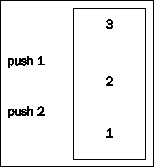A pointer may point at an object as well as a value, and a class may have a pointer to another object as a member variable, which in turn points at another object and so on. In this way, a linked list can be constructed. The list must end eventually, so the last pointer points at null. A pointer to the next cell in the list is called a link.

A stack is very valuable in a number of applications and it can be implemented with a linked list. We can add a value on top of the stack, we can inspect or remove the topmost value, and we can check whether the stack is empty. However, we cannot do anything to the values that are not on top. The method that adds a new value on top of the stack is called push and the method removing it is called pop. Let us say that we push our stack three times with the values 1, 2, and 3. Then we can only access the topmost value, 3, and not the two below, 1 or 2.

An additional point of this example is that the Value method...



